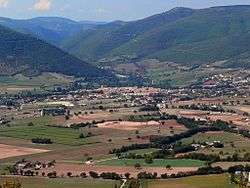Sabina (region)
- For the Roman Catholic/Eastern Orthodox Saint, see at the Basilica of Santa Sabina, and for Hadrian's wife, see Vibia Sabina.
| Sabina | |
|---|---|
| Traditional region | |
|
Landscape of Sabina at Norcia. | |
| Country | Italy |
| Elevation | 600 m (2,000 ft) |
Sabina (Latin: Sabinium), also called the Sabine Hills, is an Italian region located in the center of Italy. Named for the Sabines, Sabina is an ancient territory that was once bordered by Latium to the south, Picenum to the east; and separated from Umbria to the north by the river Nera, and from Etruria to the west by the Tiber river. Today, Sabina is mainly northeast of Rome in the regions Lazio, Umbria and Abruzzo. The Upper Sabina is in the province of Rieti (Poggio Mirteto, Magliano Sabina, Casperia, Montopoli di Sabina, Torri in Sabina, Cantalupo in Sabina, Montebuono, Forano, Poggio Catino, Montasola, Stimigliano, Castelnuovo di Farfa, Fara in Sabina, Roccantica, Mompeo, Salisano, Cottanello, Configni, Vacone, Tarano, Collevecchio, Toffia, Poggio Nativo, ecc.), and the Sabina Romana is in the province of Rome (Mentana, Monteflavio, Montelibretti, Monterotondo, Montorio Romano, Moricone, Nerola, Palombara Sabina). There is also a part of the Sabina in the Umbria Region (territories of Narni, Amelia, Cascia, Norcia, partially Upper Valnerina, etc.) and in the Abruzzo Region (from Valle dell'Aterno to L'Aquila).
History
In the Augustan division of Italy, it was included in the region IV Samnium, in Diocletian's 3rd-century redistricting, it was part of Italia suburbicaria, which was directly governed from Rome, assigned to the subdivision Valeria. With the arrival of the Lombards, the territory of Sabina was at times incorporated into the Duchy of Spoleto in the Early Middle Ages and at times formed part of the Duchy of Rome. With the rise of the Papal States, Sabina was governed directly by the pontificate or indirectly, by the counts of Sabina, a title of the noble Crescentii family in the 10th and 11th centuries. During the late 9th to early 10th century, the region was, along with much of central Italy, a stronghold of, or threatened by the Saracens.[1]
PDO Sabina extra virgin olive oil
Extra virgin olive oil Sabina is, chronologically speaking, the first Italian Protected Designation of Origin (PDO) oil to gain the certification from the European Community, the production of olives and oil is a millennial tradition in Sabine.
Colli della Sabina DOC
In 1996, the Italian government designated plantings around the Sabine Hills as a DOC wine region eligible to produce red, white and rose wine as well as some sweet sparkling wine from white grape varieties. The grapes are limited to a harvest yields of 12 tonnes/ha. Red and rose wines are a blend of mostly 40–70% Sangiovese, 15–40% Montepulciano with other local varieties permitted up to 30%. The white wines are a blend of at least 40% Trebbiano and at least 40% Malvasia with other local grape varieties permitted to make up to 20% of the remaining blend. Red and rose wines must have a minimum alcohol level of 11% with whites having a minimum of 10.5%.[2]
Suburbicarian bishopric
- See also suburbicarian diocese.
Sabina has been the seat of a Catholic bishopric since the 6th century, though the earliest names in the list of bishops may be apocryphal.
The official papal province of Sabina was established under Pope Paul V in 1605. The Cardinal Bishop of Sabina is one of the six suburbican tituli (not counting Ostia) of the College of Cardinals which carry the rank of Cardinal Bishop.
Since 1925 the Cardinal Titular Church of Sabina has been joined to that of Poggio Mirteto, a municipality of the region, and officially named Sabina e Poggio Mirteto, since 1986 Sabina–Poggio Mirteto. The current (since 2000) Cardinal Bishop of Sabina-Poggio Mirteto is Giovanni Battista Re.
See also
- Sabines
- Strada dell'Olio
- Farfa Abbey
- Province of Rieti
- Province of Rome
- Santacittarama Buddhist Monastery
References
External links
| Wikivoyage has a travel guide for Sabine Hills. |
- Sabina on-line
- Catholic Hierarchy: Sabina-Poggio Mirteto (Cardinal Titular Church
- GCatholic
- Travel Information for the Sabina
- Photos and images of Sabina
